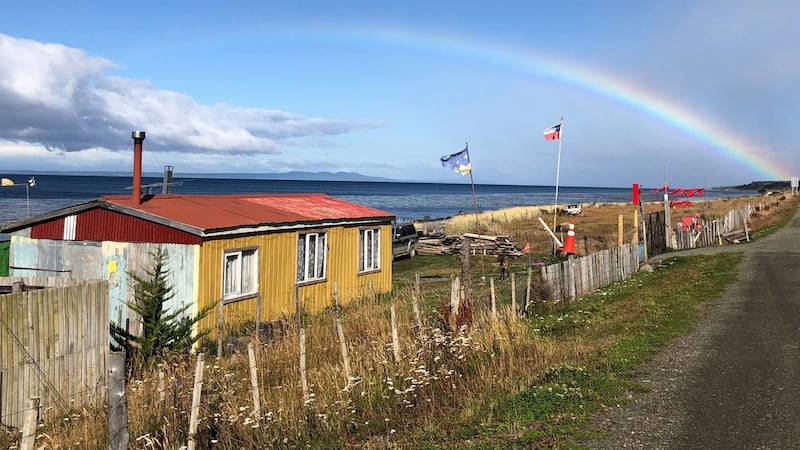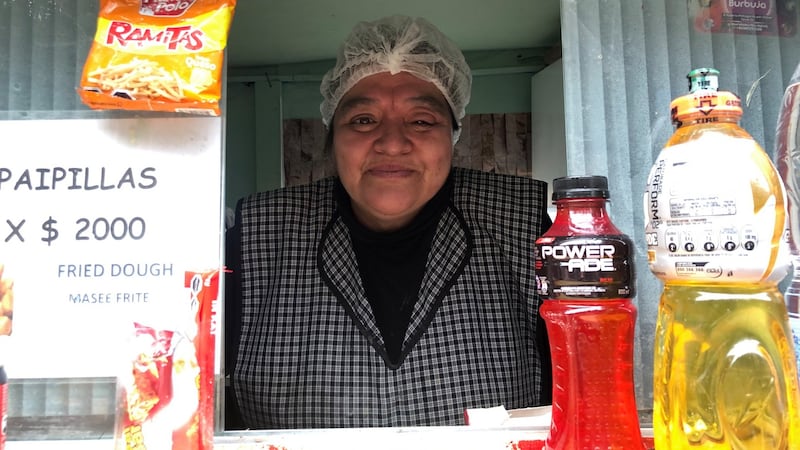The helpful woman in the ferry office had said yes. Yes, there was a ferry from Punta Arenas to Porto Williams. It would be Thursday, the day after tomorrow, sailing at 6pm, check-in at 5pm. It would be a long sail: disembark at 1am Saturday – more than 30 hours later. But hey, it would be a trip of wonderful scenery: through the Strait of Magellan, out into the Pacific and back in again, into the Beagle Channel; bike and food included in the fare.
However, by the time I returned to her the following day to say, okay, I’ll take that option, the Chilean government had intervened. No foreigners were to be allowed board any ferry. Sorry. A case of the coronavirus had been detected in Porto Williams, it seemed.
My long-cherished dream of hiking across Isla Navarino, the most southerly inhabited island of the Americas, and roughing it overnight in the Refugio Charles, a wooden shack on the shore of Lago Windhond, was not to be.

The virus lasted 72 hours on plastic, said the doctor. I could see Eliana looking at all the plastic light switches
So instead, I took the road out of Punta Arenas heading south on the Brunswick Peninsula, and rode to the point where a big sign announced: Fin de Camino – the end of the road. That is, the end of the last bit of road on continental America. Yes, there are roads further south - though not much, 150 kilometres perhaps – but they are on islands: Isla Grande de Tierra del Fuego and on the Isla Navarino itself.
But I could get to the end of the road of continental America and that’d have to do.
Edgy about coronavirus
Earlier, it was clear that Punta Arenas's inhabitants were getting increasingly edgy about the virus. At breakfast, Eliana, who runs the hostel in which I have been staying since my dash across the border from Argentina, sat silently watching a TV news magazine programme.
Two anchors and two studio guests, one a doctor, vied for attention on a TV screen split into four competing segments. The virus lasted 72 hours on plastic, said the doctor. I could see Eliana looking at all the plastic light switches, at the door handles, the handle of the hot water dispenser and wondering (a) were they safe to touch and (b) do I have to keep disinfecting them so they are safe to touch?
The virus lasted four hours on clothes, said the doctor. The anchors interrupted and talked over each other. A ticker tape of written info scrolled across the bottom of the screen. And all the while, low-level percussion noise was pulsating away in the background, a production device to ratchet up the air of crisis and drama.
I thought it best to leave poor Eliana to her worries and hopped on the bike.
The road out of Punta Arenas hugged the western edge of the strait. It was beautiful, even in the rain – a calm sea beneath a lead grey sky. No wind, thank god. In the distance, brooding islands and the tops of mountains disappeared into low cloud.
Tiny shacks lined much of the seashore, some tumbledown, some well-kept. It wasn’t always clear whether they were homes for people who make a living from the sea or cute holiday boltholes for city families. Most were made of corrugated iron sheets or timber, sometimes reinforced by having flattened out old oil barrels tacked onto the wood.
Many were painted gaily but a lot were in such a poor state of disrepair, paint peeling, window frames collapsing; structures were near to collapse. Every few miles, clusters of fishing boats were beached – literally – for repairs and refurbishment in makeshift boatyards and, surrounding them, the detritus thrown up in such places.
Despite the rain, and the road running out of tarmac just above a tiny beach named Bahia Mansa, where it gave way to a gravel track that spat muck and grit all over me and the bike, it was a lovely ride. A local fox, a big, dark brown fellow with a very bushy, near-black tail, ambled along the side of the road; I paused and we stared at each other.
Other wildlife abounded. There were Magellan, or upland, geese in estuaries and in the sea or along the shoreline, Magellan oystercatchers (very like our own, really), kelp gulls, imperial cormorants and the big brown Chilean skua.
Poor Pringle Stokes
Around one corner there appeared, cut into the hillside a few feet above the gravely track, a tiny cemetery of 10 graves, one of which, in the centre, was marked with a large, well-maintained wooden cross. This is known locally as the Cementerio Ingles – the English Cemetery.
The big cross tells a sad, if incomplete, story. An inscription on it reads:
In memory of Commander Pringle Stokes RN HMS Beagle who died from the effects of the anxieties and hardships incurred while surveying the western shores of Tierra del Fuego 12-8-1828.
Pringle Stokes was just 31 when, having joined the Royal Navy aged 12, he assumed command of the Beagle on its first excursion into the region. The Beagle was a survey ship whose second of three voyages into the region included a passenger, Charles Darwin, whose subsequent writings, in The Voyage of The Beagle and On The Origin of Species, completely revolutionised our understanding of ourselves and the natural world around us.

Poor old Stokes has a wonderful view, and I wouldn't mind having to put up with it myself, winter or summer
Stokes described this area in June 1828 and, even though it was then in the depth of the southern hemisphere winter, I find it hard to reconcile his description of this place with what I see before me.
“Nothing could be more dreary than the scene around us,” Stokes told his diary. “The lofty, bleak and barren heights that surround the inhospitable shores of this inlet were covered, even low down their sides, with dense clouds, upon which the fierce squalls that assailed us beat, without causing any change . . .
“Around us, and some of them distant no more than two-thirds of a cable’s length, were rocky inlets, lashed by a tremendous surf; and, as if to complete the dreariness and utter desolation of the scene, even the birds seemed to shun its neighbourhood. The weather was that in which . . . ‘the soul of man dies in him’.”
Stokes locked himself in his cabin for four weeks before shooting himself in the head. Sadly, he didn’t die instantly but lingered, conscious and apparently coherent, before dying from the effects of gangrene 11 days later, on August 12th, 1828.
There’s a little hand-knitted red teddy bear-style figure tied to a chain by the cross. Whoever left it, and why, is not apparent. But poor old Stokes has a wonderful view, and I wouldn’t mind having to put up with it myself, winter or summer. It is a very peaceful spot.
Who occupies the other nine graves is not stated.
Hippy-esque cafe
Further on, the mud and gravel road deteriorates significantly but carries on over the meandering and very beautiful San Juan river and continues to hug the coast, sometimes losing the battle with beach shingle, at other times almost being gobbled up by the forest covering the looming headland of Cape Froward.
It finally comes to an end, as a road of any shape or form, with that large sign announcing Fin de Camino, as if that were not obvious. A rickety wooden fence puffs itself up and says “that’s far enough”, even if you are an intrepid biker. A path meanders on and hikers may continue to the San Isidro lighthouse and indeed Cape Froward itself.

She's a jolly lady serving piping hot coffee and tea and doing a steady line in deep-fried dough
Me? I’m prepared to be seduced by the hippy-esque cafe at the end of the road at the bottom of the Americas.
It is a makeshift, extraordinary mess of a place – a trailer tacked onto the back of an ancient minibus. The trailer is a rusting hulk whose continued existence defies time, logic and the elements, if not the laws of physics. Parts of the metalwork have been repaired to the point of absurdity. Other bits of the café are held together by sheets of wood.
The façade, if that’s not too grand a description, is flashed, wigwam-style, by upright staves of varying height and thicknesses in the midst of which is a serving hatch.
Inside the gloom, a head is just about visible. It’s Marta, wondering what I want. She’s a jolly lady serving piping hot coffee and tea and doing a steady line in deep-fried dough, which one may eat with either a dollop of tomato ketchup or sugar. Flexible dining is, I believe, the technical term. I take the sweet option, and Marta is delighted.
There’s a tarpaulin pinned to the side of the adjoining derelict bus (in which Marta sleeps betimes) and under it are two youngsters, Marcia and Ignacio, both from Santiago and evidently besotted with each other. They are painting a penguin on the side of the bus and a giant map of the cape.
“We travel and Marta look after us,” says Ignacio.
I take their picture and say, “Well, you look after each other.”
Ignacio puts his arm around Marcia’s shoulder and gives her a squeeze.
And she looks at him adoringly.
Marta sticks a hand out her hatch. I clasp it, somewhat recklessly but in friendship (and sneakily gel my hand a few seconds later). I hope this really isn’t the end of the road . . .
Peter Murtagh is travelling through the Americas by motorbike, from southern Chile to Alaska, for an Irish Times series. This is part two of his travelogue. Read part one here.
Peter Murtagh’s articles continue next week





















